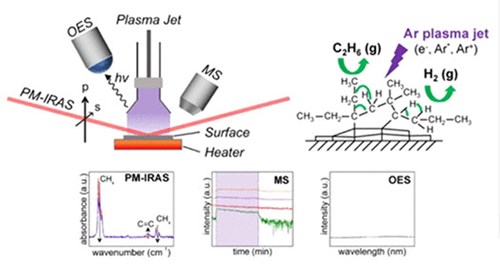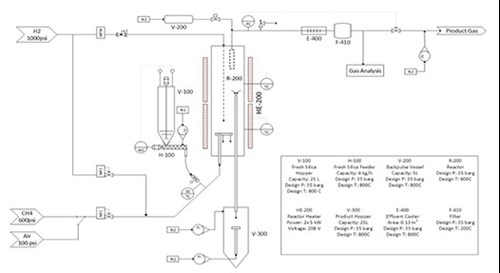Converting natural gas emissions to viable products
The United States (U.S.) has more than 2 million active, abandoned or repurposed wells, as well as its oil and natural gas pipeline network, compressor stations and other oil and natural gas infrastructure that emit approximately 8 million tons of methane annually (a greenhouse gas, equivalent to 200 million tons of carbon dioxide (CO2)—the amount of annual CO2 emissions from 400,000 vehicles). Significant progress has been made over the past decade for detecting and quantifying methane emissions at the source, using surface-based technologies like hand-held measurement devices and vehicle-based detection sensors, but these technologies cannot quickly assess large areas.
Other technologies, such as atmospheric sensing equipment, attached to satellites or manned and unmanned aircraft, can better estimate the volume of methane emissions across wide areas. Even though there are a variety of emissions mitigation solutions available, flaring of produced methane, plus associated products, is the most common solution when takeaway capacity is insufficient, or economics are not favorable for transport and processing. However, due to the greenhouse implications of flaring, other options are being explored that would transform methane into marketable products through low-temperature, greenhouse-gas-free methods.
One of the main areas of interest of the U.S. Department of Energy’s (DOE) Methane Mitigation Technologies program, supported by the National Energy Technology Laboratory (NETL), is to develop process-intensified technologies for the conversion of flare/venting gas (mainly methane) into transportable, value-added liquid products. However, the current technologies for natural gas to liquids (GTL) are facing significant challenges, including:
- The deployment and intermittent operation at isolated sites often lacks convenient access to electricity, make-up water, and other required services; and
- The GTL technologies (e.g., indirect catalytic conversion of methane to liquid chemicals via synthesis gas) are confirmed to be complicated, inefficient and environmentally unfriendly (enormous CO2 emission), requiring large economies-of-scale to compete in existing commodity markets, and relying on extensive supporting infrastructure to be available.
This means that indirect GTL technologies are presently impractical for meeting the program’s objectives. Thus, the research foci have changed, and now focus on converting methane that is being flared into liquid and solid products, with production criteria that include:
- Development of new catalysis materials
- Processes that can operate without convenient access to electricity and make-up water and with highly efficient conversion at a lower temperature
- Modular, compact, integrated and transportable reactor designs
- Technology platforms capable of producing a variety of products.
Below are two NETL-funded projects that align with the current directives to develop efficient natural gas conversion technologies that produce marketable solids and liquids to mitigate methane emissions into the atmosphere.
Process Intensification by a One-Step, Plasma-Assisted Synthesis of Liquid Chemicals from Light Hydrocarbons (DE-FE0031862). This project’s goal, led by the University of Notre Dame, is to use plasma stimulation of a light hydrocarbon resource to synthesize value-added liquid chemicals. This work will evaluate the hypothesis that the plasma will serve multiple roles in this transformative chemistry, including activation of carbon-hydrogen (C-H) bonds at low bulk gas temperature and pressure, providing a fast response for immediate startup and shutdown. This enhances the lifetime of the catalyst through plasma-assisted removal of surface impurities, and provides a means to activate nitrogen (N2) to allow for the direct formation of chemicals containing nitrogen–carbon (N-C) bonds. In addition, the project will explore the potential for exploiting these processes more broadly, by building on recent discoveries using plasma-assisted methods to convert hydrogen and N2 feeds, Fig. 1.

FIG. 1. A newly designed multimodal spectroscopic instrument combining polarization modulation infrared reflection-absorption spectroscopy (PM-IRAS), mass spectrometry, and optical emission spectroscopy (OES) for the investigation of plasma−surface interactions.
This project offers the opportunity to assess a potential mechanism to reduce quantities of flared gas at oil and natural gas production sites, where gas transport options are insufficient or do not exist, by converting the gas to energy-dense liquid products. In addition to providing a value-added pathway for use of the gas, the proposed technology will also offer environmental and economic benefits through the reduction of CO2 emissions caused by the flaring of light hydrocarbon feeds and through the potential use of CO2 as a soft oxidant. All of these factors offer the potential to meaningfully contribute to ensuring U.S. security and prosperity by addressing energy and environmental challenges through transformative science and technology solutions.
Project accomplishments, thus far, include completing construction of three plasma-stimulated reactor systems that are leak-free and demonstrate successful hydrocarbon nitrogen coupling at lower bulk temperatures. Experimental procedures and data collection methods were developed to quantify the liquid products and capture operating and performance parameters for the reactors and materials. To fully understand the reaction mechanism, in-situ spectroscopy was implemented successfully to identify surface-adsorbed intermediates from plasma stimulation, using the plasma reactor. The project team plans to further develop the approach with additional in situ characterization and computer simulation. Additional experimental testing, including alternative plasmas, such as gliding arc, will also be evaluated.
For further information, please contact Robert Noll at NETL (robert.noll@netl.doe.gov).
Modular Processing of Flare Gas for Carbon Nanoproduct (DE-FE0031870). The goal of this project, led by the University of Colorado, is to develop a low-cost and easily scalable natural gas decarbonization process to form nanoparticles and nanofibers, to be used as a structural additive in concrete. This project will focus on the synthesis of the carbon nanoproducts through chemical vapor deposition, and on the impact of these fibers to the durability of the concrete. The process is conceptualized to be modular/mobile for manufacture on a skid, with easy transport between gas wells and a high turndown ratio to handle production rate changes.
Domestically produced carbon nanoproducts from natural gas is an attractive solution to our nation’s economic, environmental and energy concerns. This project focuses on natural gas decarbonization for flare gas reduction through conversion to carbon nanoproducts. The research and development in this project will result in a mobile unit that provides a high-quality carbon nanoproduct that addresses current challenges faced by flare gas processing in remote areas.
The carbon nanoproducts provide value to the concrete industry for their ability to mitigate cracking and improve infrastructure lifetimes. Current costs for ultra-high-performance concrete make it a novelty product; this innovation in chemical engineering will enable durable concrete infrastructure and allow for the growth of carbon fiber-reinforced products in additive manufacturing applications. Research developments in the processing approach will also enable larger-scale centralized gas decarbonization.
Project accomplishments, thus far, include completion of modifications to a laboratory reactor to integrate a proprietary fluidization system of the silica fume. This was operated successfully at 900°C and the mechanical conceptual designs were completed to incorporate the components into a modular system. The concrete mix using the produced carbon product was optimized for compressive strength and fluidity, meeting the performance metrics set with mixes using commercially available carbon nanofibers.
An initial techno-economic analysis for the approach shows a 25% investor’s rate of return, assuming the carbon nanoproduct-coated silica that is produced can achieve a selling price of $2 to $4 per kilogram. The project team plans to continue with the lab-scale testing while constructing a skid-mounted modular version of the reactor, Fig. 2. A process also will be developed for a large-scale synthesis of the required catalyst.

FIG. 2. Process flow diagram for the proposed modular version of the reactor, utilizing chemical vapor deposition to create carbon nanoproducts from natural gas for use as a concrete additive.
For further information, please contact William Fincham at NETL (William.Fincham@netl.doe.gov).
A larger list of natural gas conversion projects supported by NETL includes:
Microwave Catalysis for Process Intensified Modular Production of Carbon Nanomaterials from Natural Gas (FE0031866) West Virginia University
Oxidative Aromatization Catalysts for Single Step Liquefaction of Distributed Shale Gas (FE0031869)
North Carolina State University
Electrocatalytically Upgrading Methane to Benzene in a Highly Compacted Microchannel Protonic Ceramic Membrane Reactor (FE0031871)
Clemson University
One-Step Non-Oxidative Methane Upgrading to Hydrogen and Value-Added Hydrocarbons (FE0031877)
University of Maryland College Park
Methane Partial Oxidation Over Multifunctional 2-D Materials (FE0031878)
University of South Carolina
Production of Hydrogen and Carbon from Catalytic Flare Gas Pyrolysis (FWP-1022467)
National Energy Technology Laboratory
Commercialization Study of NETL Technology for Flare Gas to Olefins and Liquids (FWP-1022467)
National Energy Technology Laboratory
Microwave Enhanced Flare Gas Conversion to Value-Added Chemicals (FWP-1022467)
National Energy Technology Laboratory
Additional details about NETL can be found at www.netl.doe.gov.
DISCLAIMER
“This report was prepared as an account of work sponsored by an agency of the United States Government. Neither the United States Government nor any agency thereof, nor any of their employees, makes any warranty, express or implied, or assumes any legal liability or responsibility for the accuracy, completeness, or usefulness of any information, apparatus, product, or process disclosed, or represents that its use would not infringe privately owned rights. Reference herein to any specific commercial product, process, or service by trade name, trademark, manufacturer, or otherwise does not necessarily constitute or imply its endorsement, recommendation, or favoring by the United States Government or any agency thereof. The views and opinions of authors expressed herein do not necessarily state or reflect those of the United States Government or any agency thereof.”
ACKNOWLEDGMENT
KeyLogic Systems, Inc.’s contributions to this work were funded by the National Energy Technology Laboratory under the Mission Execution and Strategic Analysis contract (DE-FE0025912) for support services.
- Regional Report: Mega-transitions are underway in the Middle East (October 2025)
- U.S. drilling slows as high operating costs, low oil prices and capital restraint motivate operators (September 2025)
- Reinforcing safety as global activity revitalizes offshore (August 2025)
- Cost-effective bottomhole flow diagnostics in mature PDP assets using nanoparticle tracers: A case study from East Texas (June 2025)
- Bringing geosteering efficiency to coiled tubing drilling operations on the North Slope of Alaska (March 2025)
- Wood’s Hall sees oil and gas projects progressing while energy transition work gains scale (February 2025)
- Subsea technology- Corrosion monitoring: From failure to success (February 2024)
- Applying ultra-deep LWD resistivity technology successfully in a SAGD operation (May 2019)
- Adoption of wireless intelligent completions advances (May 2019)
- Majors double down as takeaway crunch eases (April 2019)
- What’s new in well logging and formation evaluation (April 2019)
- Qualification of a 20,000-psi subsea BOP: A collaborative approach (February 2019)


